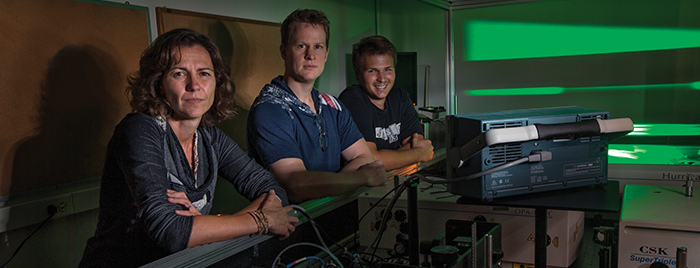Consumption of energy is increasing worldwide due to the steady increase in the human population and the long-term growth of the international economy. A group of researchers at a northwestern Ohio science lab have been leveraging Ohio Supercomputer Center services to investigate solar-based fuel production as a sustainable alternative to fossil fuels.
A solar fuel is an energy source produced from sunlight by way of artificial photosynthesis or thermochemical reaction. Solar fuel can be produced and stored for later use, providing energy in the evenings or on cloudy days when sunlight is not available, making it an attractive potential alternative to petroleum and other fossil fuels.
“The main energy sources used nowadays—fossil fuels—are not a good solution to our demands, because the fuel reserves are expected to dry out in several hundreds of years and the build-up of atmospheric carbon-dioxide produced from fuel causes serious environmental problems, such as global warming,” said Ksenija Glusac, Ph.D., an associate professor of chemistry at Bowling Green State University. “One of the most promising alternative energy sources is light from the Sun, which we can use to split water molecules into hydrogen—a fuel—and oxygen.”
The process requires catalysts to initiate the oxygen and hydrogen-evolving chemical reactions, and the elements currently known for their water-splitting qualities are among the rare and costly transition metals. Some of the most commonly used transition metals for this process are iridium and ruthenium oxides for water oxidation and platinum for water reduction, because they bind the key catalytic intermediates in an optimal way, not too weakly yet not to strongly.
In order to achieve a wider implementation of hydrogen-evolving catalysts in solar fuel production, Glusac’s group is focusing on catalysts made of more earth-abundant elements, such as carbon, hydrogen, nitrogen and oxygen. These catalysts are inspired by the naturally occurring cofactors, namely nicotinamide adenine dinucleotide (NAD+) and its reduced variant (NADH), which perform similar reduction processes in our bodies.
“Our research is at the interface between organic and physical chemistry, and we accordingly use techniques common to both of these fields,” said Glusac, whose research team is based at the university’s Center for Photochemical Sciences. These techniques include a number of laboratory experiments, known as in-vitro studies, as well as computer simulation experiments, known as in-silico studies.
Computational screening of potential photohydrides is an important part of the study. Glusac’s group employs a simple quantum mechanical modeling approach, known as the density functional theory (DFT) method, on OSC’s HP/Intel Oakley Cluster to calculate the relevant thermodynamic parameters for the ground and excited-state hydride transfer reactions. An excellent match was obtained between the calculated and experimental values for several organic hydride donors; the researchers are now applying the methodology to a large series of model photohydrides and evaluating possible candidates for experimental studies.
If successful, this project will provide new guidance on the conversion of abundant energy from the Sun to sustainable fuels and value-added chemicals, thereby providing alternatives to the limited reserves of problematic petroleum-based sources.
###
Written by Jamie Abel, (614) 292-6495; jabel@oh-tech.org
Project Lead: Ksenija Glusac, Ph.D., Bowling Green State University
Research Title: Towards organic photohydrides: Excited-state hydride release in metal-free models
Funding Source: National Science Foundation, American Chemical Society, Bowling Green State University
Website: bgsu.edu/photo/glusac

